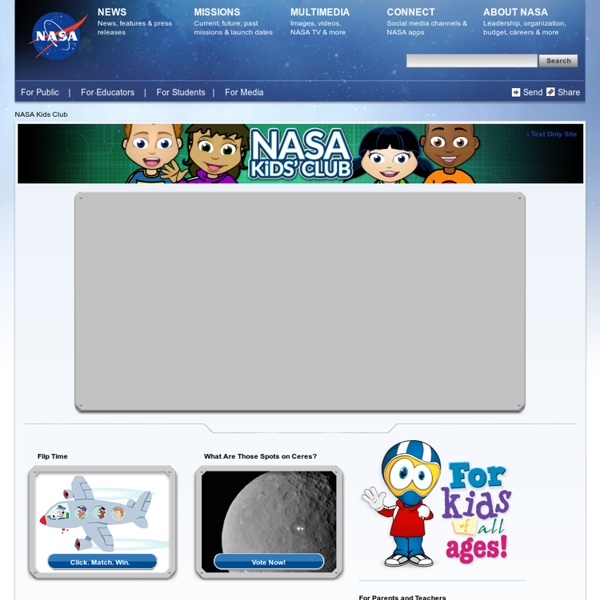Kids' Club
Skip to main content NASA Kids Club › Text Only Site Flip Time Click. What Are Those Spots on Ceres? Vote Now! Orion Puzzles and Coloring Sheets Print and Play. Space Racers Watch. For Parents and Teachers Teach your kids and students safe surfing habits.› Children's Protection Act Learn about what you can do to protect your privacy online.› Page Last Updated: May 12th, 2015 Page Editor: Flint Wild Skip to main content NASA Kids Club › Text Only Site Flip Time Click. What Are Those Spots on Ceres? Vote Now! Orion Puzzles and Coloring Sheets Print and Play. Space Racers Watch. For Parents and Teachers Teach your kids and students safe surfing habits.› Children's Protection Act Learn about what you can do to protect your privacy online.›
Basics of Space Flight
The people of Caltech's Jet Propulsion Laboratory create, manage, and operate NASA projects of exploration throughout our solar system and beyond. Basics of Space Flight is a tutorial designed primarily to help operations people identify the range of concepts associated with deep space missions, and grasp the relationships among them. It also enjoys popularity with college and high-school students and faculty, and people everywhere who are interested in interplanetary space flight. This website attempts to offer a broad scope, but limited depth, as a robust framework to accommodate further training or investigation. Many other resources are available for delving into each of the topics related here; indeed, any one of them can involve a lifelong career of specialization. This module's purpose is met if the participant learns the scope of concepts that apply to interplanetary space exploration, and how the relationships among all of them work. Interplanetary exploration begins . . .
Hopscotch: Coding for kids, a visual programming language
10 NASA Inventions You Might Use Every Day
In 1958, President Eisenhower signed the Space Act, officially creating the National Aeronautics and Space Administration. From the beginning, the purpose for the new branch extended beyond space ships and moon boots. The law stipulated that its research and advancements should benefit all people, and in its 50-year history, NASA has certainly fulfilled that role. Although most people today will never set foot on the moon, everyone likely comes in contact with a NASA by-product every day. Each year since 1976, NASA has published a list of every commercialized technology and product linked to its research. But it doesn't take a rocket scientist to use many of these so-called spinoffs. NASA research extends beyond space flight into our everyday lives.Image Credit: Joe Drivas/Getty Images 10. Many teenagers cringe at the prospect of braces. Invisible braces are made of translucent polycrystalline alumina (TPA). Even celebs have teeth problems. 9. 8. 7. 6. 5. The Tang Myth 4. 3. 2. 1.
Free Interactive e-Books from NASA Reveal History, Discoveries of the Hubble & Webb Telescopes
Earlier this month NASA announced that the Hubble Space Telescope found evidence of a planet forming 7.5 billion miles from its star. This astonishing discovery challenges all of our current theories about how planets develop. A few days later, Hubble captured images of two galaxies merging. Hubble has been in orbit since 1990, collecting images with one of the largest and most versatile telescopes designed for deep space. Hubble’s development, launch and discoveries are the subject of a new, free interactive e-book (best viewed on the iPad) that brings to life Hubble’s distinguished service as our eye on the universe. For almost as long as Hubble has been in space, NASA has been working on the next generation space telescope. Its large mirror and distant viewing position are expected to give Webb’s images higher resolution and sensitivity, allowing scientists to study the birth and evolution of galaxies as well as the formation of stars and planets. Related Content:
Related:
Related:



